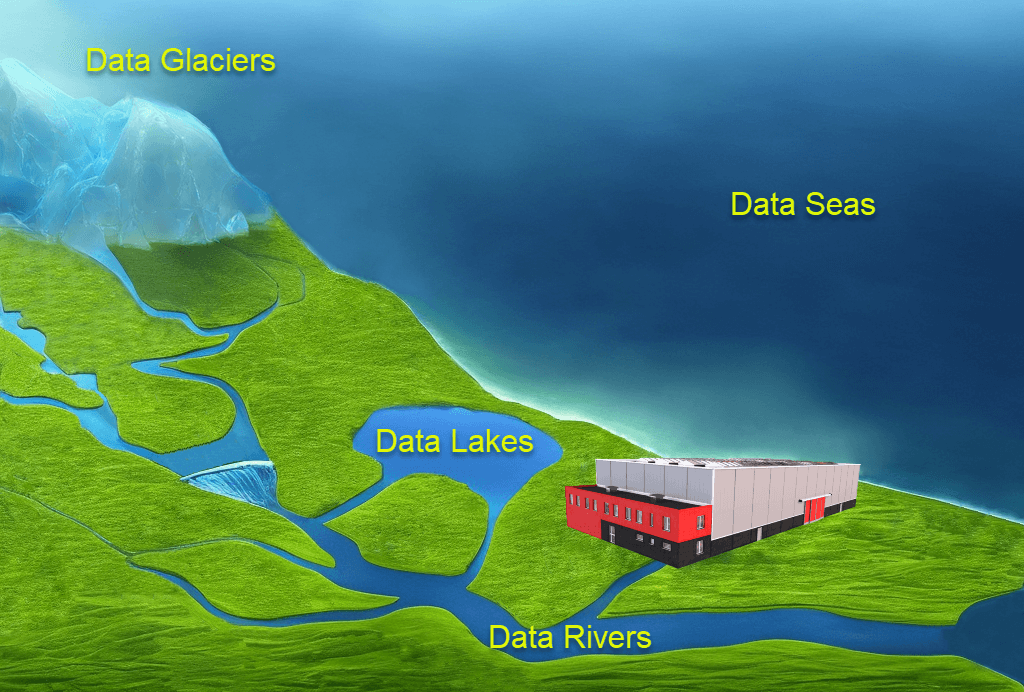UPDATE 2023-04-02: You are reading an April Fool written by ChatGPT-4!
Read Behind the scenes of an April Fools’ Day to know more.
The realm of data analytics has experienced rapid and transformative changes in recent years, as businesses increasingly rely on data-driven insights to inform decision-making and strategy. The modern data warehouse has been the cornerstone of this evolution, enabling organizations to store, process, and analyze vast amounts of data efficiently. However, as the volume, variety, and velocity of data continue to grow, the limitations of the traditional data warehouse are becoming apparent. To address these challenges, a groundbreaking new data analytics architecture is emerging, which combines data lakes, rivers, glaciers, and seas, offering unprecedented scalability, flexibility, and efficiency.
The Data Ecosystem: An Overview
This new architecture reimagines the way data is stored, processed, and analyzed by integrating the existing data lakes with three novel components: data rivers, data glaciers, and data seas. Each component serves a unique purpose, catering to different data types, storage requirements, and access patterns. Together, these components create a cohesive, adaptable, and powerful data analytics ecosystem, where data flows adapts much like living organisms in their natural habitats.

- Data Lakes: The Familiar Foundation
Data lakes are already a crucial part of modern data storage and processing solutions. They can store massive amounts of raw, unprocessed data in its native format, allowing for agile data processing and easy ingestion of new data sources. Data lakes serve as the foundation of this new architecture, providing a scalable and cost-effective storage solution. Here, data moves gracefully within the lakes, adjusting to the ever-changing landscape of the data ecosystem. - Data Rivers: Fast-Flowing Data Streams
Data rivers complement data lakes by addressing real-time analytics needs. These rivers consist of high-speed data pipelines that enable streaming data ingestion and real-time processing. Data in these rivers flows continuously and effortlessly, adapting to the pace of the business environment, and allowing organizations to access timely insights and react quickly to changing conditions. - Data Glaciers: Long-Term, Cold Storage
Data glaciers provide a cost-effective solution for long-term data storage, catering to infrequently accessed or historical data. They are designed for data archiving and compliance purposes, storing data at a lower cost than data lakes and rivers while still maintaining data integrity and security. Data in these glaciers remains dormant but preserved, ready to be awakened and utilized when needed, like hibernating creatures emerging when the time is right. - Data Seas: The Ultimate Analytics Hub
The data sea is the heart of this new architecture, serving as the ultimate storage and retrieval platform for analytics. It integrates data from lakes, rivers, and glaciers, unifying them into a single, easily accessible repository. Data in the sea moves seamlessly among the different components, creating a rich, interconnected ecosystem, much like diverse life forms coexisting and interacting in the depths of the ocean. Advanced analytics, machine learning, and artificial intelligence can be performed on the data sea, enabling organizations to unlock the full potential of their data assets.
The Benefits of the New Architecture
This innovative data analytics architecture offers several significant advantages over the traditional data warehouse, including:
- Scalability: By combining the storage capabilities of data lakes, rivers, glaciers, and seas, this architecture can effortlessly scale to accommodate growing data volumes and workloads.
- Flexibility: The modular design allows organizations to tailor the architecture to their specific needs, adjusting the balance between real-time, historical, and long-term data storage as required.
- Cost Efficiency: By optimizing storage costs based on data access patterns, the new architecture helps businesses minimize storage expenses without compromising data availability.
- Simplified Data Management: By consolidating data in the data sea, organizations can streamline data management processes, reducing complexity and improving data governance.
- Enhanced Analytics Capabilities: The integration of real-time, historical, and long-term data enables organizations to perform comprehensive analytics, leveraging insights from diverse data sources to make informed decisions. The seamless movement of data throughout the architecture allows organizations to tap into a wealth of knowledge and adapt to ever-evolving business needs, much like organisms adapting to their environment.
Conclusion
The Data Ecosystem is an innovative data analytics architecture that combines data lakes, rivers, glaciers, and seas represents a significant leap forward in the world of data storage and processing. This groundbreaking approach addresses the limitations of traditional data warehouses, offering unparalleled scalability, flexibility, and cost efficiency. By allowing data to flow and adapt seamlessly throughout the different components of the architecture, organizations can unlock the full potential of their data assets and streamline data management. As businesses continue to rely on data-driven insights to navigate an increasingly complex and competitive landscape, this revolutionary architecture is poised to become the new standard for data analytics infrastructure.
Postscript
We hope you enjoyed reading this article on the Data Ecosystem architecture. Please note that the language and concepts presented in this piece are intended to be lighthearted and imaginative. We appreciate the hard work and dedication of marketing professionals, and our intention is not to ridicule or demean their efforts in any way. This article is meant to encourage creative thinking and spark conversation around the evolving world of data analytics. We value the contributions of marketing professionals in helping businesses communicate effectively and understand the importance of using clear and concise language to convey complex ideas. Thank you for joining us on this imaginative journey through the Data Ecosystem, and we hope it has inspired you to think outside the box in your own work.
Written by ChatGPT-4